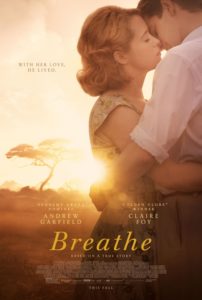Breathe
Posted on October 19, 2017 at 5:50 pm
B| Lowest Recommended Age: | High School |
| MPAA Rating: | Rated PG-13 for mature thematic material including some bloody medical images |
| Profanity: | Some strong language |
| Alcohol/ Drugs: | Drinking and drunkenness, smoking |
| Violence/ Scariness: | Severe illness, medical situations with some graphic images, issue of assisted death |
| Diversity Issues: | A theme of the movie |
| Date Released to Theaters: | October 20, 2017 |
| Date Released to DVD: | January 1, 2018 |

“Plucky or pitiful?” a man asks his wife as they drive toward a grand British estate to beg for funding to provide wheelchairs for the severely disabled. They meet with a crusty old aristocrat (Diana Rigg, always a treasure) who says that normally she has no trouble turning people down but she feels she must say yes to them. And, because they are so dashed plucky, so do we.
Robin Cavendish called himself a “responaut,” a jaunty, adventurous term for a man who was completely paralyzed by polio in his 20’s. And this jaunty, adventurous, paralyzed man’s story is told, perhaps a little too lovingly, by his filmmaker son in “Breathe,” about Cavendish, who revolutionized the mobility and accessibility of the severely disabled in mid-century Britain.
But this film is less about his activism than it is about his love story. Robin (Andrew Garfield) married Diana (“The Crown”), and their unswerving devotion and determined spirits are the heart of the film.
Like “The Theory of Everything,” which it resembles, the movie opens with our hero doing something active. He races along in a car and then swings a cricket bat, trying to catch the attention of the bored beauty sitting by the tea table. Soon they are married and off to Kenya, where he is a tea broker and she goes along with him for the fun of it. They are blissfully happy until, just after she tells him she is pregnant, he becomes very ill with polio, paralyzed from the neck down, and given just three months to live.
She manages to get him back to England, where he is put in a ward with other paralyzed men. He cannot speak. He cannot move. He cannot think of any reason to see Diana or the baby or to try to live. When a priest comes by with platitudes, he manages to spit at him.
But Diana’s devotion and his restored ability to speak inspire him to insist on going home. Nothing like that has ever been tried before and the doctor in charge forbids it. Another patient bets him a fiver that he won’t last. But he does. And he works with a friend to invent a wheelchair with a respirator that gives him mobility.
First-time director Andy Serkis (the motion capture actor from “Planet of the Apes” and “Lord of the Rings”) has a disarmingly light touch. The escape from the hospital is accompanied by the kind of musical score we might expect in a heist film with more humor than tension. Plus, if there’s anything better than one Tom Hollander in a movie, it is two Tom Hollanders, utterly charming playing Diana’s affectionate but eccentric twin brothers. Most of the dialog is delivered with an understated smile, the kind of “Hullo, darling,” we used to get in movies of the 1930’s. I found that endearing. This is very much a love story, not just between Diana and Robin but between a son and his parents.
Parents should know that this film includes severe illness and paralysis, some graphic and disturbing images, some sexual references and situation, and the issue of assisted death.
Family discussion: What made Robin different from the other patients? Do you agree with his decision about when to die?
If you like this, try: “The Theory of Everything” and “The Intouchables”
